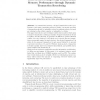29 search results - page 1 / 6 » Improving Architecture-Based Self-Adaptation through Resourc... |
DAGSTUHL
2009
13 years 5 months ago
2009
An increasingly important concern for modern systems design is how best to incorporate self-adaptation into systems so as to improve their ability to dynamically respond to faults,...
DAGSTUHL
2009
13 years 5 months ago
2009
To deal with the increasing complexity of software systems and uncertainty of their environments, software engineers have turned to self-adaptivity. Self-adaptive systems are capab...
IPPS
2003
IEEE
13 years 9 months ago
2003
IEEE
Exploiting speculative thread-level parallelism across modules, e.g., methods, procedures, or functions, have shown promise. However, misspeculations and task creation overhead ar...
IM
2003
13 years 6 months ago
2003
: Monitoring is a fundamental building block of any network management system. It is needed to ensure that the network operates within the required parameters, and to account for u...
HIPEAC
2009
Springer
13 years 9 months ago
2009
Springer
Abstract. In transactional memory, aborted transactions reduce performance, and waste computing resources. Ideally, concurrent execution of transactions should be optimally ordered...

